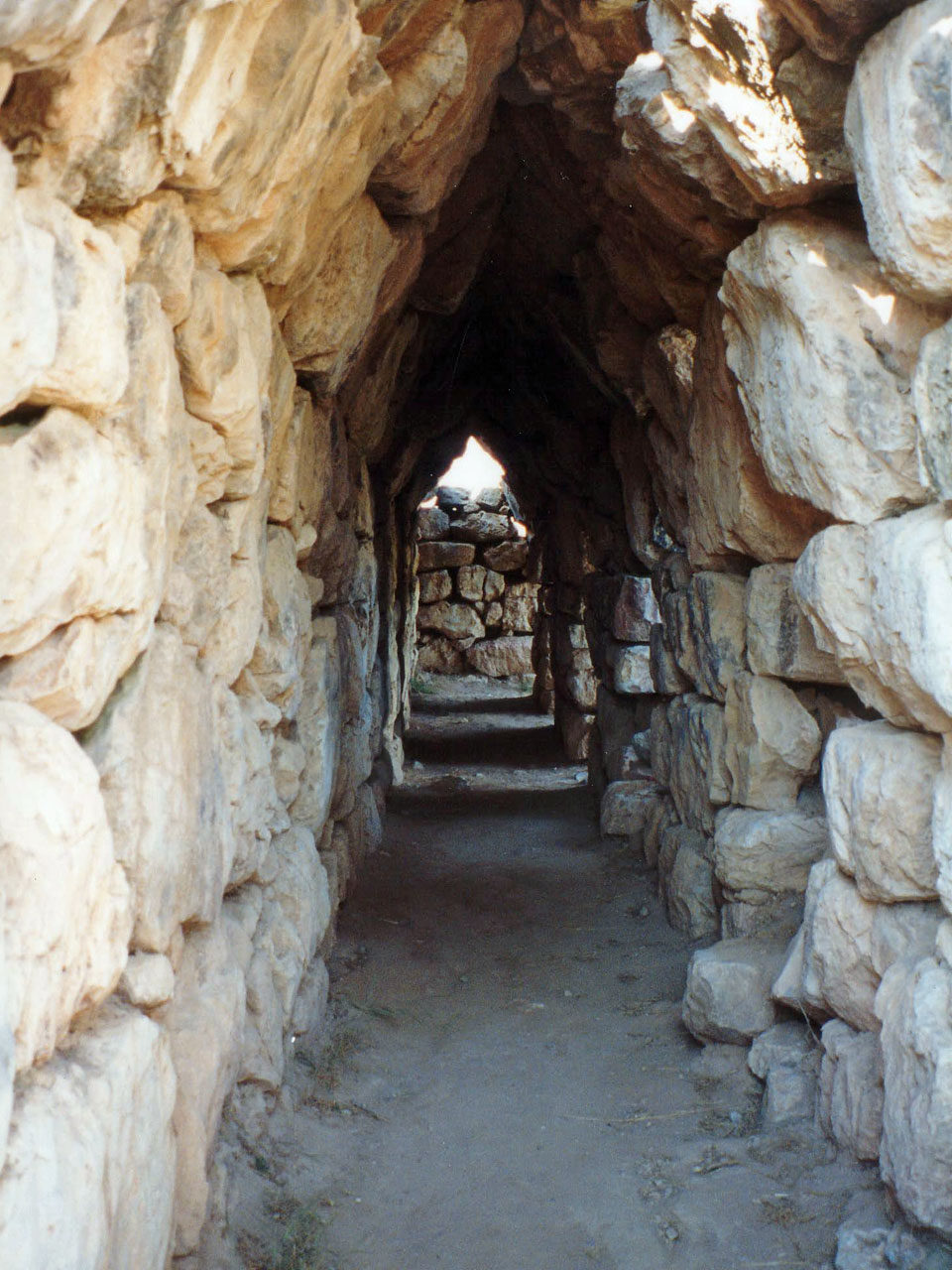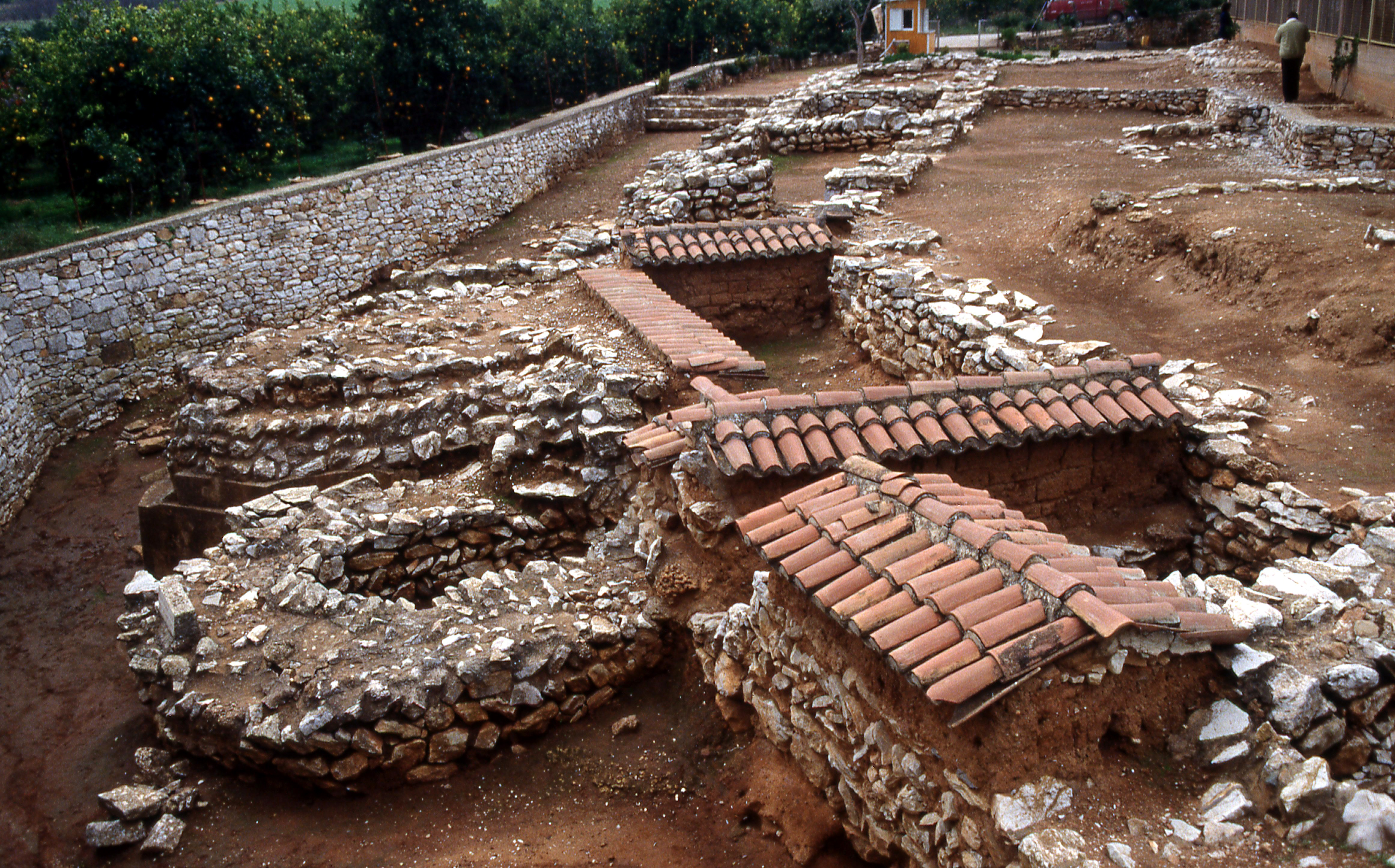|
Tiryns Culture
Tiryns culture (2,200 - 2,000 BC) or Early Helladic III was an Early Bronze Age culture in Central Greece, Southern Greece and the Ionian islands (Part of Western Greece) that followed Eutresis and Korakou cultures, and preceded the Mycenean civilization. The "center" of the culture was the settlement of Tiryns that saw further development during the Mycenean period. * Metal and Terracotta: A unique pattern-painted dark to light human figurine appears in Tiryns culture's Lerna IV while old types of animal figurines do not continue. Metal is now more popular for the creation of weapons and tools, some examples are : A dagger, a nail, a pin from Lerna and three axes from Thebes. * Pottery: The best known type of pottery consists of two classes of pattern-painted ceramics : 1) Patterned ware that is a dark on light class, mainly in the Peloponnese. The ornament is geometric and almost exclusively rectilinear. 2) Ayia Marina ware that is a light on dark class, mainly in Central Gree ... [...More Info...] [...Related Items...] OR: [Wikipedia] [Google] [Baidu] |
Eutresis Culture
Eutresis culture is a Final Neolithic and early Bronze Age culture in mainland Greece, also known as Early Helladic I in Helladic chronology. It was developed directly out of central and southern Greek Final Neolithic culture, and lasted roughy from c.3200 to c.2650 BC. * Materials and architecture: stones, bones, clay objects and rarely metal are the main materials that were used in everyday life. A distinct fabric was employed for cooking vessels, which were normally dark surfaced. Several jars for storage and cooking were discovered. Signs of fortifications have been discovered in Perachora area. It is believed that the vast majority of the houses were simple with one or two rooms. * End: it was followed by the more advanced Korakou culture in Greece during the Early Helladic II period of the Early Helladic chronology Helladic chronology is a relative dating system used in archaeology and art history. It complements the Minoan chronology scheme devised by Sir Arthur Evan ... [...More Info...] [...Related Items...] OR: [Wikipedia] [Google] [Baidu] |
Korakou Culture
The Korakou culture or Early Helladic II (in some schemes Early Helladic IIA) was an early phase of Bronze Age Greece, in the Early Helladic period, lasting from around 2650 to c.2200 BC. In the Helladic chronology it was preceded by the Eutresis culture of c. 3200 – c. 2650 BC (also called Early Helladic I) and followed by the Tiryns culture (2,200–2,000 BC) or Early Helladic III. In some parts of Greece a Lefkandi culture, or Early Helladic IIB, follows the Korakou; elsewhere the Korakou transitions directly into the Tiryns. Remains of the culture have been excavated widely across south and central mainland Greece, in the Peloponnese, Attica, Euboea, Boeotia, Phocis, and Locris. Examples of Korakou pottery have been found still more widely, as far as Knossos in Crete, Lefkas in the west, Thessaly, and on Ios and Keos in the Cyclades. Many coastal sites were fortified, and in several areas the period ends with a destruction by burning; some settlements are reoccupied b ... [...More Info...] [...Related Items...] OR: [Wikipedia] [Google] [Baidu] |
Mycenaean Greece
Mycenaean Greece (or the Mycenaean civilization) was the last phase of the Bronze Age The Bronze Age is a historic period, lasting approximately from 3300 BC to 1200 BC, characterized by the use of bronze, the presence of writing in some areas, and other early features of urban civilization. The Bronze Age is the second pri ... in Ancient Greece, spanning the period from approximately 1750 to 1050 BC.. It represents the first advanced and distinctively Greek civilization in mainland Greece with its palatial states, urban organization, works of art, and writing system.Lazaridis, Iosif et al.Genetic origins of the Minoans and Mycenaeans. ''Nature'', 2017Supplementary Information "The Mycenaeans", pp. 2–3).. The Mycenaeans were mainland Greeks, Greek peoples who were likely stimulated by their contact with insular Minoan civilization, Minoan Crete and other Mediterranean Sea, Mediterranean cultures to develop a more sophisticated sociopolitical culture of their own. The ... [...More Info...] [...Related Items...] OR: [Wikipedia] [Google] [Baidu] |
Tiryns
Tiryns or (Ancient Greek: Τίρυνς; Modern Greek: Τίρυνθα) is a Mycenaean archaeological site in Argolis in the Peloponnese, and the location from which the mythical hero Heracles performed his Twelve Labours. It lies south of Mycenae. Tiryns was a hill fort with occupation ranging back seven thousand years, from before the beginning of the Bronze Age. It reached its height of importance between 1400 and 1200 BC, when it became one of the most important centers of the Mycenaean world, and in particular in Argolis. Its most notable features were its palace, its Cyclopean tunnels and especially its walls, which gave the city its Homeric epithet of "mighty walled Tiryns". Tiryns became associated with the myths surrounding Heracles, as the city was the residence of the hero during his labors, and some sources cite it as his birthplace. The famous megaron of the palace of Tiryns has a large reception hall, the main room of which had a throne placed against the righ ... [...More Info...] [...Related Items...] OR: [Wikipedia] [Google] [Baidu] |
Ministry Of Culture And Sports (Greece)
The Ministry of Culture and Sports ( el, Υπουργείο Πολιτισμού και Αθλητισμού) is the government department of Greece entrusted with preserving the country's cultural heritage, promoting the arts, and overseeing sport through the subordinate General Secretariat for Sports. The incumbent minister is Lina Mendoni. The Deputy Minister for Modern Culture is Nicholas Yatromanolakis, and the Deputy Minister for Sports is . History This ministry was established in 1971 as the Ministry of Culture and Sciences () and it was renamed the Ministry of Culture () on 26 July 1985. On 7 October 2009, it was merged with the Ministry of Touristic Development to form the Ministry of Culture and Tourism (). It ceased to exist on 21 June 2012, when the Ministry of Tourism was re-established and the culture portfolio was absorbed by the Ministry of Education, Lifelong Learning and Religious Affairs to form the Ministry of Education, Religious Affairs, Culture and Sports ... [...More Info...] [...Related Items...] OR: [Wikipedia] [Google] [Baidu] |
Lerna
In classical Greece, Lerna ( el, Λέρνη) was a region of springs and a former lake near the east coast of the Peloponnesus, south of Argos. Even though much of the area is marshy, Lerna is located on a geographically narrow point between mountains and the sea, along an ancient route from the Argolid to the southern Peloponnese; this location may have resulted in the importance of the settlement. Its site near the village Mili at the Argolic Gulf is most famous as the lair of the Lernaean Hydra, the chthonic many-headed water snake, a creature of great antiquity when Heracles killed it, as the second of his labors. The strong Karstic springs remained; the lake, diminished to a silt lagoon by the 19th century, has vanished. Lerna is notable for several archaeological sites, including an Early Bronze Age structure known as House of the Tiles, dating to the Early Helladic period II (2500–2300 BC). Myths The secret of the Lernaean spring was the gift of Poseidon when he l ... [...More Info...] [...Related Items...] OR: [Wikipedia] [Google] [Baidu] |
Thebes, Greece
Thebes (; ell, Θήβα, ''Thíva'' ; grc, Θῆβαι, ''Thêbai'' .) is a city in Boeotia, Central Greece. It played an important role in Greek myths, as the site of the stories of Cadmus, Oedipus, Dionysus, Heracles and others. Archaeological excavations in and around Thebes have revealed a Mycenaean settlement and clay tablets written in the Linear B script, indicating the importance of the site in the Bronze Age. Thebes was the largest city of the ancient region of Boeotia and was the leader of the Boeotian confederacy. It was a major rival of ancient Athens, and sided with the Persians during the 480 BC invasion under Xerxes I. Theban forces under the command of Epaminondas ended Spartan hegemony at the Battle of Leuctra in 371 BC, with the Sacred Band of Thebes, an elite military unit of male lovers celebrated as instrumental there. Macedonia would rise in power at the Battle of Chaeronea in 338 BC, bringing decisive victory to Philip II over an alliance of Thebes ... [...More Info...] [...Related Items...] OR: [Wikipedia] [Google] [Baidu] |
Peloponnese
The Peloponnese (), Peloponnesus (; el, Πελοπόννησος, Pelopónnēsos,(), or Morea is a peninsula and geographic regions of Greece, geographic region in southern Greece. It is connected to the central part of the country by the Isthmus of Corinth land bridge which separates the Gulf of Corinth from the Saronic Gulf. From the late Middle Ages until the 19th century the peninsula was known as the Morea ( grc-x-byzant, Μωρέας), (Morèas) a name still in colloquial use in its demotic Greek, demotic form ( el, Μωριάς, links=no), (Moriàs). The peninsula is divided among three administrative regions of Greece, administrative regions: most belongs to the Peloponnese (region), Peloponnese region, with smaller parts belonging to the West Greece and Attica (region), Attica regions. Geography The Peloponnese is a peninsula located at the southern tip of the mainland, in area, and constitutes the southernmost part of mainland Greece. It is connected to the mainlan ... [...More Info...] [...Related Items...] OR: [Wikipedia] [Google] [Baidu] |
Geometric Shapes
Geometric Shapes is a Unicode block of 96 symbols at code point range U+25A0–25FF. U+25A0–U+25CF The BLACK CIRCLE is displayed when typing in a password field, in order to hide characters from a screen recorder or shoulder surfing. U+25D0–U+25FF The CIRCLE WITH LEFT HALF BLACK is used to represent the contrast ratio of a screen. Font coverage Font sets like Code2000 and the DejaVu family include coverage for each of the glyphs in the Geometric Shapes range. Unifont also contains all the glyphs. Among the fonts in widespread use, full implementation is provided by Segoe UI Symbol and significant partial implementation of this range is provided by Arial Unicode MS and Lucida Sans Unicode, which include coverage for 83% (80 out of 96) and 82% (79 out of 96) of the symbols, respectively. Block Emoji The Geometric Shapes block contains eight emoji: U+25AA–U+25AB, U+25B6, U+25C0 and U+25FB–U+25FE. The block has sixteen standardized variants defined to specify ... [...More Info...] [...Related Items...] OR: [Wikipedia] [Google] [Baidu] |
Helladic Chronology
Helladic chronology is a relative dating system used in archaeology and art history. It complements the Minoan chronology scheme devised by Sir Arthur Evans for the categorisation of Bronze Age artefacts from the Minoan civilization within a historical framework. Whereas Minoan chronology is specific to Crete, the cultural and geographical scope of Helladic chronology is mainland Greece during the same timespan (c.3200–c.1050). Similarly, a Cycladic chronology system is used for artifacts found in the Aegean islands. Archaeological evidence has shown that, broadly, civilisation developed concurrently across the whole region and so the three schemes complement each other chronologically. They are grouped together as "Aegean" in terms such as Aegean art and, rather more controversially, Aegean civilization. The systems derive primarily from changes in the style of pottery, which is a benchmark for relative dating of associated artifacts such as tools and weapons. On the basi ... [...More Info...] [...Related Items...] OR: [Wikipedia] [Google] [Baidu] |

.jpg)




